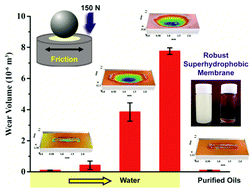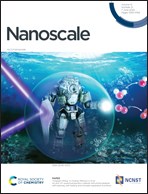Water deteriorates lubricating oils: removal of water in lubricating oils using a robust superhydrophobic membrane†
Abstract
Water is recognized as a contaminant in lubricating oils. Recently, interfacial materials with special wettability have been broadly developed for oil–water separation. However, solving lubricating oil failure caused by water remains a challenge. Here, a robust superhydrophobic membrane is presented to effectively remove water in lubricating oils to recover their lubricating capability. Compared to pure lubricating oils without or with an additive, lubricating oils collected from their emulsions using the superhydrophobic membrane have an equivalent friction coefficient and wear volume, which are much lower than that of lubricating oils contaminated by water. Water in lubricating oils accelerates the oxidation of metallic substrates and wear corrosion. Moreover, the metallic ions dissolved in water-containing lubricating oils induce the catalytic dehydrogenation of lubricating oils, leading to the deposition of a good deal of carbon-based wear debris. Importantly, the prepared membrane shows steady performance in regard to extreme water repellency, high-efficiency purification of lubricating oils, and low wear volume even after harsh mechanical damage. Robust interfacial materials have potential advantages in practically solving lubricating oil failure caused by water.



 Please wait while we load your content...
Please wait while we load your content...